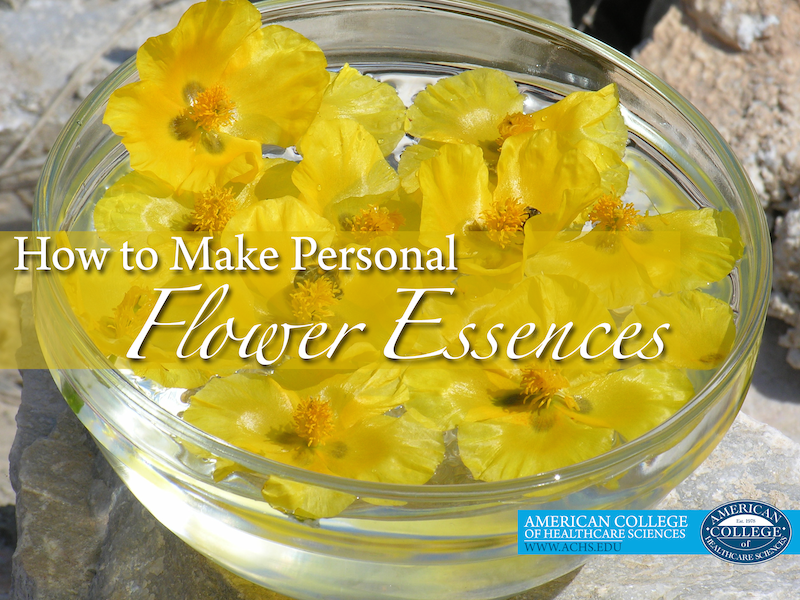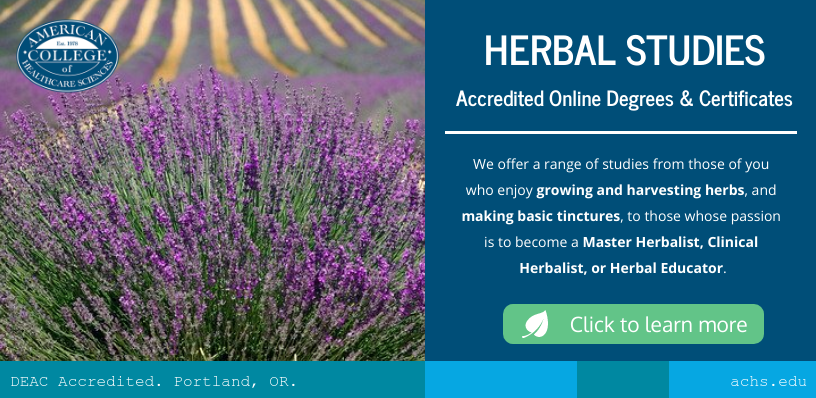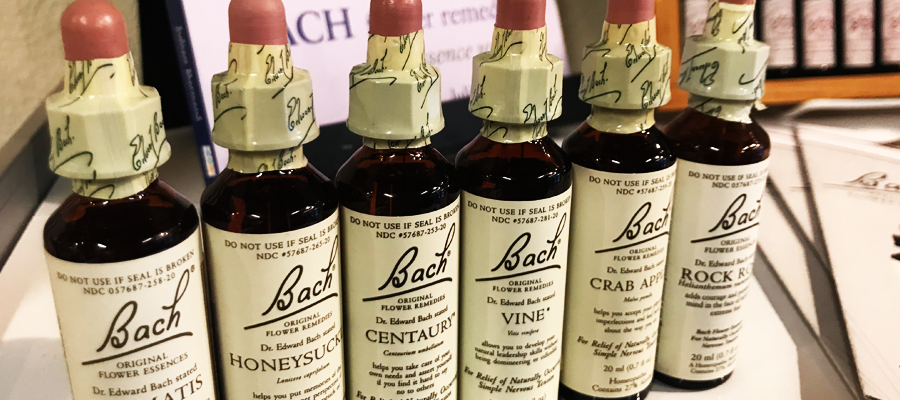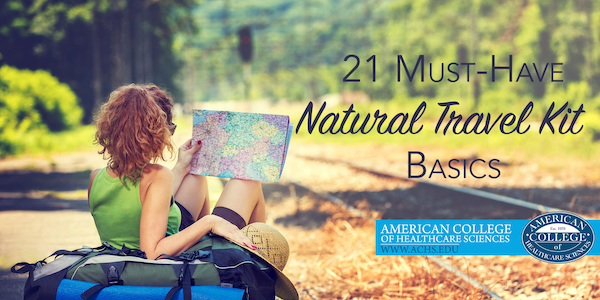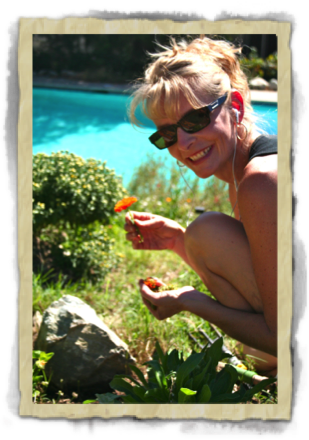He loves me, he loves me not? As children, we believed in the magical power of these words as we plucked the petals off of a daisy, hoping of course, to end with “He loves me!” We blew the fluffy seeds off of a dandelion and made fantastical wishes. And no one ever forgets their first gift of a dozen roses. Flowers are a part of our mystical journey, from birth till death. Their language speaks to us, long after the blooms have faded.
Flowers affect the senses; our noses, enamored by a euphoric aroma, can send our memories whirling back in time. Maybe you can recall when, as a child, you pulled the stamens out of the center of a yellow honeysuckle flower to taste its sweetness on your tongue.
But beyond these senses, flowers have the ability to work on a higher plane––a vibrational level with our very souls. Yarrow Treefriend explains in her book, Blossoms of Light:
Flower essence therapy works primarily as an energetic catalyst to bring changes in psychological patterns. The results of these changes may have physical manifestations as well, but these are mainly of a preventative nature.
How Do Flower Essences Work
British physician Edward Bach left allopathic medicine in the 1930’s to focus solely on flower essences. He became the founder and creator of 38 Bach Essences and one emergency formula, Rescue Remedy, all still on the market today. Bach was well aware of the energetic imprint that the individual flowers infused into water.
When made in attunement with nature and the flowers themselves, the essences work on the aura/emotional level of our bodies. Flower remedies also have a natural affinity to the seven energy centers of the body known as chakras: Root Chakra (grounding and security), Sacral Chakra (relationships/sex), Solar Plexus (self-esteem), Heart Chakra (giving and receiving love), Throat Chakra (self-expression/communication), Brow or Third Eye (mental clarity), and the Crown Chakra (soul consciousness and the divine).
Flower essences have no side effects or contraindications. They are ideal for use with children and animals. They can be taken in a variety of ways: orally, added to your bath, mixed with your lotion and applied directly to your skin, or spayed as a mist that can be absorbed from the air.
You can’t take too much or too little. However, they differ from traditional medicines. The old adage that less is more applies to vibrational remedies. Perhaps, the most wonderful thing about flower essences is that you can make them yourself with no expensive doodads, just a few basics to get started. All you need is a keen sense of intuition and a devoted love of nature and flowers!
Choosing Your Flower Essence
Choosing an essence can be as simple as selecting a flower that you feel a particular attraction to. You can choose a flower that is already growing in your garden or through pictures.
If working with premade essences, there are a few ways that you can choose the right one. Try intuitive vibrational techniques such as using your hands to “feel” the energy of a particular essence; this may be felt as a sensation of warmth and tingling when passing your open palms above the essences. Other methods practitioners use in addition to intuition include the use of a pendulum (Radiesthesia), muscle testing (Kinesiology), or use of the Doctrine of Signatures (i.e., pick pink flowers for the heart chakra, violet/purple for the crown chakra, and so on).
Every flower has a fingerprint unique to its own vibration. When working with flower essences, it’s important to recognize that the individual essences are bi-polar in nature, addressing both the “problem” and the “solution.” This requires honest self-reflection. Selections are based on individual history: goals, strengths, weaknesses, relationships, and life experiences.
Preparing a Flower Essence
The first essence that you make will be the base of your flower essences, the Mother Essence. This Mother Essence will be further broken down into a stock bottle and finally if desired, a dosage bottle.
Before you begin, it is important that all of your supplies are sterilized. Choose a sunny morning before the dew has dried to gather your flowers. You will be placing the bowl, elevated if you can, in the vicinity of where you have gathered them so try to choose a spot that will get at least three hours of sunlight.
Supplies to Make Your Flower Essence:
- Two, two ounce glass dropper bottles, dark (amber/cobalt/green) in color. The extra bottle is for breaking the stock bottle into a dosage bottle if desired.
- Small glass funnel.
- Clear glass or crystal bowl that is dedicated for making flower essences.
- A glass jar (Mason jar) with four to six ounces of fresh spring or well water. Do not use distilled water as the ionization process used to distill it destroys the water’s life force.
- A leaf, such as a cabbage or lettuce leaf to place flowers on before adding to the water.
- Brandy or vegetable glycerin/apple cider vinegar as a preservative.
- Garden shears or scissors used specifically for gathering flowers.
- Labels. Be sure to record the time, date, location as well as the essence(s) contained.
How to Make Flower Essences Step-by-Step
Step 1 – Choose and Gather Your Flowers
When you’re ready to gather your flowers, take the water from the Mason jar and add it to the crystal bowl. Spend some time communing with your chosen plant/flowers. Be sure to explain to the plant what you plan to do and ask for permission. This may seem silly, but plants are living, breathing beings! Remember that your flow of energy goes in to each essence you make.
Gather flowers that are near maturity. Follow your intuition, clipping just the flower heads (without touching them) and let them fall onto the leaf.
Step 2 – Add Your Flowers to Water
When you have gathered enough flowers for your Mother Essence, add them to the surface of the water, face up so that they are not touching.
Let the bowl with the flowers sit undisturbed in the sun for approximately three to four hours.
Step 3 – Choose and Gather Your Flowers
Using a leaf, you can remove the flowers from the water. Place them under the plant you have gathered them from and offer thanks.
Step 4 – Prepare Your Stock Bottle
Add the brandy or other preservative with spring water into the stock bottle, about a half-and-half solution, and then add four to seven drops of the Mother Essence. Activate the essence by vigorously shaking the bottle and tapping it against your palm, dispersing the molecules into the water. Be sure to shake the essences each time before using. If making a dosage bottle, just repeat this process.
Step 5 – Use Your Flower Essence
Dosage from the stock bottle is four drops under the tongue or in a little water up to four times a day. Take upon waking and retiring, at noon and at evening meals. However, do not take directly with food. Be sure to store out of light and heat.
Start by working with a single essence. As you gain experience, you can then combine three to six essences focusing on key issues. There may be a temporary increase in symptoms until negative patterns are released. If needed, increase the frequency of the essence, not the dose size. Engage in activities that work synergistically with the flower essences, such as journaling and using positive affirmations that will help recharge your subconscious.
Flower Choices to Get You Started
Beebalm Mondardo didyma: A favorite of the hummingbirds, and an excellent choice to put some zip back in to your life, physically and spiritually. Use bee balm flower essence to add some ‘spark’ to your life.
Bleeding Heart Dicentra formosa: A perennial, easily recognized by its dangling locket-like hearts, this essence has an affinity with the heart chakra. Those who have had broken hearts may find catharsis with bleeding heart, though it is recommended to do so gradually. It can restore harmony and peace to the heart.
German Chamomile Matricaria recutita: German chamomile is easily recognized by its delicate flowers with their sunny yellow center and white ray petals. Look to chamomile for feelings of stress and unbalance. The solar plexus chakra is soothed by the calming of chamomile.
Columbine Aquilegia canadensis: Columbine once seen is not soon to be forgotten for its ethereal beauty. Columbine is useful for those who suffer from self-esteem issues.
Honeysuckle (common) Lonicera caprifolium: Use the flower essence of honeysuckle if you find yourself lost in nostalgia, that “I want to go home again,” feeling. Honeysuckle will save you from drowning in the past, be it a long lost childhood or the loss of a relationship. It can allow you to move forward with your life in a positive direction, learn from past experiences, and move forward.
What flowers will you use to make your next flower essence? Share with me in the comments!
This article is for informational purposes only. It is not intended to treat, diagnose, cure, or prevent disease. This article has not been reviewed by the FDA. Always consult with your primary care physician or naturopathic doctor before making any significant changes to your health and wellness routine.
Disclosure of Material Connection: I am a student of American College of Healthcare Sciences, the Institution that publishes this blog. However, all opinions are my own. This blog may contain affiliate links. I am disclosing this in accordance with the Federal Trade Commission’s 16 CFR, Part 255: “Guides Concerning the Use of Endorsements and Testimonials in Advertising.”
References and Resources
Print Resources
Cunningham, D. (1992). Flower remedies handbook. New York: Sterling Publishing.
Heaven, R., & Charing, G. H. (2006). Plant spirit shamanism. Vermont: Destiny Books.
Kaminski, P., & Katz, R. (2004). Flower essence repertory. California: Flower Essence Society.
Montgomery, P. (2008). Plant spirit healing: A guide to working with plant consciousness. Vermont: Bear & Company.
Robintree, O. (2013). Flower essences for transformation & healing. Hummingbird Remedies.
Shepard, M. (2013). Partnering with nature. California: Celestial Gardens.
Treefriend, Y. (1984). Blossoms of light. Earthfriends.
Virtue, D., & Reeves, R. (2012). Flower therapy. California: Hay House.
Whitehurst, T. (2013). The magic of flowers. Minnesota: Llewellyn Publications.
Online Resources
Australian Bush Flower Essences, www.abfeusa.com
Flower Essence Society, www.flowersociety.org
The Bach Centre, www.bachcentre.com

